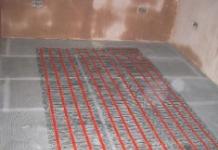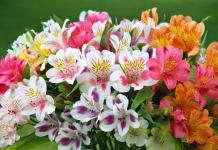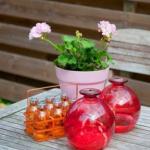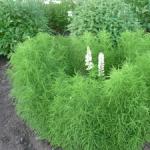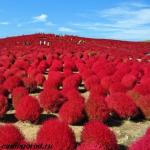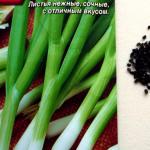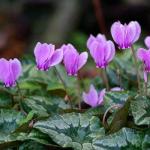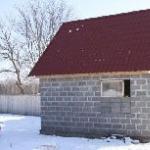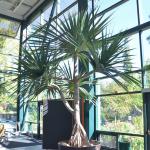Description and features of kochia
It is slender, small (usually less than a meter high), fluffy, belonging to the Marev subfamily. Kochia interesting for its unusually narrow leaves, at a superficial glance so similar to needles that many mistakenly take it for a prickly coniferous fauna.
However, appearances are deceiving, because fresh tender shoots are very pleasant and soft to the touch. For this quality, the people called kohiyu– broom, making beautiful bath brooms from her twigs.
The birthplace is China, it was in this ancient country that a significant number of varieties of this flora were bred, brought to Europe by the German professor Koch several centuries ago, which gave rise to the name.
Pictured is Kochia Sultan
It immediately attracted the attention of gardeners with its originality, as well as the ability to change the color of the leaves as it grows. How can you be sure of photo of kochia, young are covered with emerald, light green leaves.
However, after just a few months, the color scheme changes radically, taking on pink, raspberry and other shades. On cypress cochia similar to a clear pyramidal shape of the crown. In addition, as it turned out, the shrub tolerates pruning painlessly, regaining its lost splendor in a very short time.
Excellent decorative properties, giving scope for the creative imagination of designers, have become the reason for the active cultivation of this flora in many countries and parts of the world for a long period.
Modern gardeners use fast-growing, densely branching to decorate flower beds, borders and fences, in landscaping kochia extremely in demand. It may be annual or perennial.
It looks great planted in boxes and pots displayed in front of the house. In flowerbeds it goes well with fragrant tobacco, and other summer ones. When planting bushes at a short distance, they make a wonderful fluffy hedge.
Appearance, which takes on with the onset of autumn, depending on the variety, yellow, pink, purple, bronze and crimson-red hues, it only gets better in this cool season. And cut and dried branches can serve as a wonderful material for making winter compositions in designer bouquets.

In the photo, red kochia
summer cypress kohiyu called in the common people, in the scientific literature - bassia. The leaves of the plant are fed to silkworm caterpillars. Flora is also famous for its healing properties, which have long been used in Chinese medicine to relieve itching and fever.
Now, for the manufacture of medicinal infusions and decoctions, an inconspicuous and inconspicuous-looking kochia flower, as well as the leaves and stems of the culture, its fruits and seeds.
These funds are used for various diseases, and without any contraindications. Ointments from the elements of the plant treat diseases of the skin and nails. From the leaves of kochia, an extremely healthy soup is prepared, by the way.
Planting and propagation of kochia
This plant is characterized by extremely fast reproduction. The strength of growth inherent in the seeds is quite sufficient for spreading by self-sowing, and germination at growing cochia very high, almost one hundred percent, which makes the cultivation of this plant extremely convenient and feasible even for inexperienced gardeners.
However, those who want to have it on their site should make sure that the planting material does not expire, because it should be stored for no more than one and a half years.
In open ground cochia planted in May days, it is better if at the very beginning of the month. However, it all depends on the vagaries of the weather, because you should choose the right time when the frosts completely recede and can no longer damage the heat-loving flora.

Planting kochia
Kochia does not tolerate temperature extremes, and in the future it should be borne in mind that prolonged autumn frosts can kill. Since it grows and develops quite quickly, it is possible to sow much later than the previously indicated period, but only until mid-June.
First, seedlings should be grown in an area specially designated for temporary placement. And only then move the plants to the place of permanent growth. No special tricks in the science of success growing cochia from seeds does not exist.
It is enough that the seed, which needs only to be slightly pressed down, but not sprinkled on top with a layer of earth, blocking access to the beneficial rays of the sun, simply touches the moist soil. And then the nature and strength of the plant will do their job.
After the planted area is covered with a transparent film to create greenhouse conditions inside it and protect the sprouts from the cold. This shelter is removed after a couple of weeks with the arrival of real heat, and the exact period varies depending on the weather conditions.
After the emergence and strengthening of seedlings, the sprouts are thinned out, while a distance of the length of the human hand is left between the shoots. When the height of the seedlings reaches 15 cm, they should be transplanted to the place allotted for constant growth.
seeds buy kochia you can in specialized stores, if any special varieties are required, information for purchasing them is easy to find on the Internet.
Sowing can be done in late autumn. Here it is also important to correctly guess the time, it is better shortly before the onset of frost, but not earlier, so that the seeds do not have time to germinate, otherwise they will surely die in winter.

Kochia care
At the same time, the planting material is laid out along shallow grooves prepared in advance in fertile and loose soil, and in this case they must be sprinkled with a thin earthen layer (the rays of the sun during this period will not be useful, and future plants need protection from cold and wind).
It happens that the owner of a summer cottage or personal plot in the spring has a desire to please himself and those around him with the beauty of the delicate emerald leaves of this decorative as early as possible.
When to plant kochia seeds in this case? It should be done in April, even in March. In this case, future plants are first grown indoors in boxes or containers.
This process should begin with the preparation of the soil, to which river sand, humus and are added. In this case, the seeds are simply poured into shallow grooves, and the box is covered with a transparent film on top to create a suitable environment with diffused lighting for the shoots growing inside.
After the container, the soil in which should be regularly moistened in the future, is placed in a warm place in the room. It is best not to place the box directly on the windowsill, but when the sprouts appear, they should be provided with good lighting by moving them closer to the sunlight to the window. If the shoots, with unexpectedly intensive growth, begin to stretch too much, it is better to cut the tops.
After a while, the seedlings, which have reached a length of about 7 cm, are transplanted directly from the ground into separate pots. In this case, you should act carefully so that the roots of the young are not damaged.

photo of kochia seeds
But first, the soil should be prepared on the site by loosening it, adding a little ash and sand. The interval between the final planting depends on the decorative purposes of growing flora.
To create a fluffy fence, it should be about 20 cm. If the gardener wants to emphasize the beauty of each of the bushes, then the distance between them should be somewhat larger. It is a great idea to grow this flora in flower pots, homemade cochia can greatly decorate rooms and verandas.
Kochia care
It is unpretentious, in fact it requires minimal maintenance. Most importantly, it must be regular and, above all, literate. The healthy appearance of decorative fluffy bushes depends on this, which will certainly betray the original look of lawns, gardens and home gardens, for the decoration of which they are bred. Knowing the subtleties how to grow kochia, will make things a lot easier.
It should be remembered that the plant perfectly tolerates the lack of moisture, and natural precipitation may well be enough for a healthy, full-fledged growth.
However, watering, which should be judiciously regulated, is an important component in the process of caring for kochia, so it is better if the saturation of the soil with moisture is relatively frequent, and watering is at least weekly.
And again, when compiling a regime, it is necessary not to be too zealous, allowing water to stagnate on the site, which is much more dangerous than a prolonged drought. To keep the soil always moist with relatively infrequent watering, you can apply mulching with decorative stones, crushed stone or bark.
Grows well in light shade. However, it is better to choose planting kochia the place is brighter, there the conditions for development will be more favorable.

In the photo, cochia seeds sold through retail chains
For cutting, as already mentioned, the flora is very adapted, and this procedure does not create problems, giving beginner gardeners every opportunity to practice.
Kohiya is convenient for giving it bizarre, even fantastic shapes. At the same time, a plant without pruning is very quickly able to stretch to a length of more than a meter.
After a haircut, in a short time, restore the vegetative system, increase the leaves of the shrub with the help of minerals with a predominance of nitrogen, which again has a beneficial effect on the appearance and beauty of the ornamental.
In general, the first feeding should be done ten days after the germination of seedlings. Further, the procedure must be repeated during the period of active growth in a month or a little more.
Types and varieties of cochia
There are about eight dozen subspecies in the genus Kochia, but some of them are especially common and well-known. All of them are unpretentious and differ among themselves mainly in the height and shape of the bushes, as well as the color of the leaves in the autumn. Ornamental subspecies are mostly annuals.
The most popular and widely used for landscape decoration is cochia coronata or cochia broom. characterized by a spherical shape of the bushes, which become burgundy-red by autumn.

Pictured is Kochia Nephrite
This culture is convenient for growing in countries with a temperate climate, as it is able to endure frosts and slight frosts with firmness, which makes it possible to enjoy the beauty of its appearance until late autumn.
hairy kochia- a slender and tall variety, with narrow leaves lowered down, acquiring a burgundy color as they develop. Kochia jade attractive unusually fast growth and convenient to create, by cutting, from the bushes of artistic sculptors.
This decorative subspecies is considered thermophilic, but it can grow without problems in areas with depleted soil. The Childs variety is a short, rounded bush, pleasing with green foliage throughout the season.
perennial kochia little used in ornamental floriculture, but some are highly valued as fodder crops. One of these subspecies is izen. , growing to a height of no more, or even less than 50 cm.

In the photo, kokhiya broom
Branching at the base, it has the characteristic feature of spreading over the ground. puts down deep roots underground. its small, seemingly inconspicuous, seeds ripen in them by the end of summer.
The culture is rich in nutrients, quite productive, adapts well and grows in areas with a cold or, conversely, arid climate. This is a promising fodder crop, but it is also used to decorate landscapes. Most often planted in sunny beds or rocky hills.
Diseases and pests of kochia
However, it may well be that the owners of the plots that breed this plant will one day find that a spider mite has spread on pretty tender bushes.
kochia seedling it is often affected by the so-called "black leg" - a fungal disease in which the lower bases of the stems turn black, which can result in death.

Pictured is Childs cochia
A good prevention from this is tillage with a solution of manganese or ash. If the seedlings grow in a container in the room, then it is better to move it to where the temperature in the room is slightly lower.
As you can conclude, growing, resembling a gentle cloud, once brought from the blessed East, brings more pleasure than trouble.
And the beauty of cheerful multi-colored small bushes that grow in the warm season in the garden, and in winter at home in flower pots, will create a wonderful mood for the whole year.
Kochia (Kochia) or summer cypress is a fast-growing ornamental leafy plant from the Amaranth family of the Marev subfamily. The genus combines drought-resistant semi-shrub and herbaceous xerophyte plants.
Kohiya got its name in honor of the director of the botanical garden in Erlangen (Germany) Elangen Koch.
Among the people, the plant is known under the names of summer cypress, bassia, summer cyprus, izen, prutnyak, broom grass.
This plant is native to China. Cochia is cultivated in East Asia, Europe, Africa, North America, Japan and Australia.
Kochia is an annual or perennial ornamental plant with a lush, developed crown. The plant forms and takes shape in early June. It retains its appearance until the onset of frost. Height 60-150 centimeters.
Kohiya consists of an upright lignified stem and a large number of branched thin shoots. Young branches are formed along the entire length of the shoots.
The leaves are entire, thin, linear, petiolate, soft, similar in appearance to cypress needles. The leaves are covered with a short edging, often lanceolate, rarely filiform.
On a young kochia, the leaves are dark green or light green; closer to autumn, the foliage acquires a yellow, orange, raspberry or pink hue. The root is taproot, goes into the ground up to 3 meters deep.
 Kochia changes color in autumn
Kochia changes color in autumn The flowers are inconspicuous, paniculate or spike-shaped, very small, collected in inflorescences and hidden in the axils of the apical leaves. Kochia blooms from July to September.
After pollination, miniature nuts are formed in place of flowers.
In each nut, seeds ripen, which retain their germination for 2 years. If the seeds are not collected, they crumble to the ground and sprout in the spring.
Fresh kochia leaves are added to soups. The plant is used in medicine. Cochia helps with eczema, erysipelas, skin inflammation, rheumatism, edema, gonorrhea. It has diuretic, laxative, diaphoretic, cardiotonic, bactericidal and tonic properties.
In addition, livestock and silkworm caterpillars are not averse to feasting on Kochia. Some farms specifically grow this crop for these purposes.
Dried bushes can be used in the form of a broom (broom).
Species and varieties with photos
In nature, there are about 80 types of cochia. In ornamental horticulture, only a small part (about 10) is grown.
Cochia broom (paniculata) is a low, spherical plant. In autumn, the shrub becomes reddish-burgundy. The plant withstands light frosts and retains its decorative appearance until late autumn.
 Cochia broom green lace
Cochia broom green lace Perennial kochia is a strongly branching at the beginning and spread along the ground semi-shrub with a height of 10-50 centimeters.
One of the best varieties of perennial kochia is creeping kochia.
The shape of the plant depends on the place of growth. Shoots creep along the ground, rise at the ends. The length of the stems is 70 centimeters.
 Creeping Kochia - Kochia prostrata
Creeping Kochia - Kochia prostrata At first they are covered with weak or dense pubescence, the ends of the stems are almost bare, reddish in color. Leaves filiform or linear. Silky, fluffy or smooth to the touch.
Flowers are collected in spike-shaped inflorescences of 3 pieces.
Kochia woollyflower- an annual semi-shrub, 78-80 centimeters high. The stems are yellowish-green or reddish, covered with short curly hairs.
 Woolly flowered Kochia - Kochia laniflora
Woolly flowered Kochia - Kochia laniflora Kochia densely flowered- strongly branched annual. Height 130 centimeters. The branches are slightly directed upwards, arranged horizontally.
Flowers around the base are surrounded by long white hairs.
 Kochia densely flowered - Kochia densiflora
Kochia densely flowered - Kochia densiflora - an elongated-oval, slender plant, up to 100 centimeters high, 50-70 centimeters wide. The leaves are pubescent, narrow, light green in spring, burgundy in autumn. The flowers are small, collected in green balls.

Kochia Childs is a compact spherical bush, 40-50 centimeters high.
Branching shoots, strongly leafy. The leaves are light green. The color does not change throughout the year.

Based on these species, several beautiful ornamental varieties were bred:
Nephritis is a fast growing plant, reaching 100 centimeters in height. Suitable for curly haircuts. 
- a neat rounded shape, grows up to 70-100 centimeters in height. In summer, the leaves are emerald green, and in autumn they turn burgundy. The variety is suitable for sculptural haircuts. 
In addition to them, very beautiful varieties can be distinguished: Acapulco Silver, Cochia Cypress, Flame, Green Lace, Shilzi, Royal Castle and others.

Growing kochia through seedlings is considered the most effective way. In regions with a cool climate, this plant is grown from seedlings, in the south, kochia can be grown from seedlings or sown directly into the ground.
For sowing at home, you need to take seedling boxes, containers or pots, fertile soil and high-quality seeds. The earth can be collected from the garden, humus, sand and peat are added to it. Kokhiya is unpretentious, the main requirements for the earth are moisture permeability, friability. The soil should be slightly acidic or neutral.
After growing seedlings, they need to be seated in separate pots. Seating can be done in one or 2 stages. That is, diving in a container of several pieces, and then seating in separate containers. Or transplant one plant per pot.
When planting in a peat pot, seedlings are planted in open ground along with it, peat in this case plays the role of additional nutrition for the flower.

Sowing seeds for is done in late March or early April.
Seeds are sown on the surface of the soil and do not go deep.
If there is a dense layer of earth on top of the seeds, the crops may not sprout.
When buying seeds, you need to pay attention to the expiration date, otherwise you can not wait for seedlings.
Land and seed preparation
Cochia seeds are quite small and do not require special preparation.
To accelerate growth, they can be treated with any growth stimulants (Epin, Energen, Heteroauxin).
Before sowing, the soil must be calcined in the oven at a temperature of about 110 degrees for 25 minutes. The soil after calcination is treated with a solution of fungicides or a weak solution of potassium permanganate.
Land for planting should be moist, but not wet.

Small grooves are made on the surface of the earth. Seeds are carefully scattered, pressed to the ground and watered from a spray bottle.
The boxes are covered with glass, film or a transparent lid and placed in a bright place away from any heating devices. The temperature in the room should be 18-20 degrees. Watering is done with a spray gun, in the morning or in the evening, daily. The first shoots appear after 7-10 days.

When 3 main leaves appear, kochia seedlings need to be picked in pots or cups. In a container with a diameter of 10 centimeters, 3 sprouts can be planted. With such a planting, before planting in the ground, one more transplant is made into separate pots in seedlings.
The plant is light-loving and, with a lack of lighting, stretches and weakens. For additional lighting, a phytolamp is placed at a short distance from the plants. Daylight hours together with supplementary lighting should be at least 12 hours.
With excess moisture, a black leg may appear. Sick seedlings should be removed immediately. The soil is dried with charcoal, calcined sand or perlite. During watering, potassium permanganate or any antifungal drugs are added. Watering is carried out along the edges of the pot, without touching the plants.

Kohiya does not tolerate cold and shade. When choosing a place, you need to consider that the site should be bright and warm. In partial shade, the bush turns out to be more compact and low. A lowland or an area with a close occurrence of groundwater is not suitable for planting cochia.
The plant is not demanding on the soil, but fertile land with a neutral or slightly acidic reaction is considered the best option.
The soil should easily pass air and water to the roots. The semi-shrub does not need frequent watering and easily tolerates drought.
After the spring frosts have passed, you can start planting plants in a permanent place. The gap between the bushes should be at least 30-45 centimeters. Seedlings by the time of transplantation should get stronger and grow up to 15 centimeters.
Plants need to be transplanted along with an earthen clod. Pits for planting should correspond to the volume of the pot. The recesses are well spilled with warm water. The plant with the earth rolls over into the hole and is compressed by the earth.
If the seedlings were planted in peat pots, the plants are planted directly in them. Bushes quickly take root in new places and begin to grow.

Cochia seeds can be sown directly into the ground. Sowing is done both in autumn and spring. In spring, seeds are sown in mid-May. When sowing earlier, cover material should be used to protect from the cold.
For faster germination, the seeds are soaked for several days in warm water or treated with a growth stimulator. The site is dug up and loosened. A mixture of sand and peat crumbles. This mixture allows the seeds to germinate faster.
Seeds are distributed over the soil and lightly pressed with the palm of your hand.
Sprouted seeds grow faster. After a week, shoots appear. Weak shoots are removed.
When sown in autumn before winter, the seeds are sown along with sand and peat in slightly frozen ground. Seeds are not afraid of the cold, and in the spring they sprout together.
When the bushes grow, they can be seated. Between each bush, the distance should be at least 30-40 centimeters, denser cultivation leads to poor development of bushes and a rapid release of flowers.
These methods of growing cochia are less effective than the seedling method and are used only in regions with a warm climate.
Kochia can reproduce on its own.
In order for self-seeding to occur, several bushes are left in the soil until spring. During the first warm days, young shoots will appear that look like Christmas trees.

Kochia care includes watering, loosening, weeding, top dressing and pruning.
Watering is carried out using a watering can. The plant is drought tolerant. You need to water in dry weather, if the leaves of the flowers begin to fall down.
Loosening and weeding of weeds is carried out several times per season. The soil should not be crusted.
For active growth, kochia requires regular top dressing. The first fertilization is carried out 2 weeks after planting the bushes in the ground. After that, top dressing is done once a month.
For top dressing, organic matter or complex mineral fertilizers are taken. You can use mullein, ash. After shearing, for a quick restoration of the bush, extraordinary fertilizing with nitrogen-containing fertilizers is carried out.
Pruning of plants is carried out 1-2 times a month.

Kochia is quite resistant to diseases and pests. With prolonged rains, rot can develop. When rot appears, diseased bushes are removed, and healthy plants are watered with potassium permanganate.
Sometimes a spider mite may appear on the bushes. The mite damages the greenery of the plant. To combat the pest, special protective agents are used (Bitoxibacillin, Neoron, Akarin) or a decoction of ceclamen tubers, a soap solution.

Bushes easily tolerate a haircut and retain their shape for a long time.
With the help of sharp scissors and secateurs, plants take the form of a pyramid, ball, oval, rectangle, matryoshka, column, or any other shape. When planting a group of bushes, you can create a semblance of a vase; tall bright flowers are planted in the middle for this.

When landing along the tracks, you can arrange a neat sheared curb. To create miniature bushes, the tops are pinched at the stage of early development of the bushes.
After any haircut, plants need top dressing with water-soluble nitrogen fertilizers.

Tall bushes are used to decorate various buildings, arbors, in the form of hedges.
Kohiya can be planted in a single copy among ground cover plants or on a lawn, in the form of a tapeworm.

Can be planted in groups in a mixborder, in a flower bed. Kohiya goes well with roses, marigolds, asters and many other flowers. 
These lush, slender bushes make it possible to decorate any site. They are used to decorate flower beds, borders, fences.

They look great in rock gardens, rockeries, topiaries, near fountains and next to large stones.
Kochia (border shrub): video
Unpretentiousness and ease of care make kochia almost an ideal plant in the garden.
Kochia is an unusual ornamental plant with original leaves. Growing kochia is a very interesting process, and care for her is minimal. Depending on the imagination, you can easily give a different shape to this plant. His homeland is China, but today the culture is widespread everywhere: in Japan, in America, in Australia.
Its name is associated with the name of professor of botany Koch. By its appearance, the plant is very similar to cypress due to the presence of small narrow leaves. It makes excellent brooms. Kochia is a dense annual culture that tends to grow very quickly and reach a height of 1 meter. She has small flowers.
From afar, it can be confused with a representative of coniferous species, but if you look closer and touch the leaves, you can see that they have nothing in common. One of the important features of kochia is the appearance of its foliage, which turns into a bright red hue when autumn comes, which makes it look very impressive.
Its cultivation is quite an exciting activity, and caring for it does not cause problems. But she is not able to endure frosts and low temperatures. In such conditions, kochia is doomed to death. Its significant advantage is the ability to tolerate drought.
Kinds
Kohiya has more than 80 species. The Venichnaya kokhiya variety is very popular, which is divided into 2 varieties: Childs kokhiya and Hairy kokhiya. Their difference lies in the fact that with the onset of autumn, the hairy leaves change the shade of the leaves to red, and the leaves of the Childs cochia remain green throughout the season.
Here are a few more types of cochia.
- Creeping - a squat variety of shrubs.
- Woollyflowering- an annual plant 80 centimeters high with red or yellow-green stems covered with small hairs.
- Densely flowered - a strongly branching annual with a height of 130 centimeters. Its flowers are covered with white hairs.

reproduction
Quite often, reproduction is carried out. Sowing in the ground is carried out from late spring to mid-July. It can be sown in the greenhouse for seedlings in April. Kochia reproduces well by self-sowing.
In order for the seeds to sprout, good lighting is important. When sowing, they do not need to be pressed deep into the ground, just sprinkle with earth. Before germination, the ground is covered with a white cloth for about a week. It can not be removed until a stable spring temperature is established. Growth care should be regular. They need to be thinned out periodically and leave a distance between them of no more than 20 centimeters. As soon as the seedlings grow up to 15 centimeters, they are planted in a permanent place. The sprouts will tolerate short periods of cold, but outdoor seedlings will take root when there is no threat of frost.
Possibility of winter landing. To do this, the bushes are placed in a greenhouse or greenhouse and wait for the ripened seeds to begin to crumble. It is they who will sprout next year in spring. You can collect these seeds to sow them in cold soil when a constant low temperature has been established. Landing is carried out during the onset of frost. Furrows are made and seeds are poured into them, and a little soil is sprinkled on top.
Advice
When buying seeds, even from a trusted manufacturer, you should pay attention to the expiration date.

landing conditions
Kochia is a freedom-loving culture, which is why plants need to be planted at a distance of 30 centimeters from each other. If you plant them too often, then instead of a thick bush, a frail broom with stunted leaves will grow, which will not be helped by any care.
Kochia is unpretentious, but loves sunny areas and fertile soil. Acidic marshy soil does not suit her.
On free steppes and in deserts, the plant chooses sunny open places for its growth. Therefore, it must be borne in mind that its landing should be carried out in areas similar to natural ones. Then in the open field the flower will feel good, as it only tolerates light shading.

Care
During the active growth of kochia, care is needed, which consists in weeding, feeding and loosening. Fertilizer should be applied 10 days after planting, and then a month later. Do not forget to apply nitrogen fertilizers after cutting her bushes. The plant is very fond of liquid fertilizers. Bush tying is not required.
Kochia easily tolerates a lack of moisture, it can be watered only during a prolonged drought, since in this case it will begin to bloom early and lose its decorative effect. In swampy areas, rotting can begin.
Plant care also consists of a haircut, which should be done once every 2 weeks. You can form bushes within your own imagination. It looks good spherical shape, oval, cubic. You can form a column or a pyramid, create a pattern in the form of a heart.
Do not forget to inspect the plant for pests and insects. The spider mite is especially dangerous. When it is detected, the plant should be treated with "Neoron" in proportions of 1 ml of the drug per 1 liter of water. After 2 weeks, repeat the procedure.

How to plant cochia through seedlings
Planting seeds is carried out in March-April in a greenhouse or in pots with loose soil, which is pre-moistened. They are placed in a well-lit place and covered with a covering material. Cultivation is carried out at a temperature of about 20 degrees. For emerging seedlings, the optimum temperature will be up to 15 degrees. Care of seedlings consists in their diving when 3 leaves appear. They are planted in separate containers - up to 3 seedlings are placed in each. Full-fledged cultivation is possible with proper watering, loosening, weeding and fertilizing with liquid mineral fertilizer, which is best done every week.
Landing in the ground is carried out at the end of spring, when the weather pleases with warm days. When grouping seedlings between them, an interval of up to 50 centimeters is observed. If the cultivation is planned in the form of a hedge or in a border, then a sufficient distance between the seedlings will be 20 centimeters.
With the use of this bright green graceful plant, an unusual landscape design is obtained. Animated figures and even labyrinths adorn the parks and streets of many capitals around the world. Planting and growing seedlings requires minimal effort, and care does not take much time.
Kochia is an ornamental leafy plant from the Marev family. Its homeland is East Asia and Africa, although for a long time it has been actively cultivated around the world. Among the people, kochia is also known under the names "summer cyprus", "bassia", "izen", "annual cypress", "broom grass", "prutnyak". Slender, lush bushes represent a great scope for the creativity of gardeners. They decorate fences, borders and flower beds. The unpretentious nature allows even a beginner to master the care of the plant.
Botanical description
Kochia is a perennial or annual ornamental crop with a rapidly growing crown. The genus includes herbaceous and semi-shrub forms. They acquire an attractive appearance already in early June and persist until the first frost. The average height of kochia is 60-80 cm. It consists of many thin, highly branched shoots along the entire length. At the base is an upright woody stem.












Some people, when they first see kokhiya, refer it to coniferous plants. The reason for this is very narrow leaves that resemble needles. However, the foliage, like the upper part of the shoots, is very soft and pleasant to the touch. Narrow leaves have a short pubescence. Young kochia are covered with light green, emerald leaves, but within just a few months they change to pink and crimson.
In addition to decorative leaves, kochia has flowers, but tiny buds do not attract attention. They gather in paniculate inflorescences in the axils of the apical leaves. After pollination, miniature nuts ripen. Each bears only one seed, which remains viable for two years.
Types and varieties of cochia
The genus Kochia has about 80 species. In our country, only some of them are used in ornamental gardening.
Unpretentious and drought-resistant plant forms spherical bushes. In autumn, the crown turns red-burgundy tones. The plant is able to withstand even slight frosts, so it will please with a decorative appearance until late autumn.

The variety forms slender, elongated bushes up to 1 m high and 50-70 cm wide. Narrow, pubescent leaves are painted light green in spring, and become burgundy by autumn. The plant prefers sunny areas and can grow in poor soils.

Compact spherical bushes do not exceed 50 cm in height. Branching shoots are densely covered with light green foliage. It does not change color throughout the year.

Based on the listed species, breeders bred several ornamental varieties:

cultivation
Kochia is grown from seeds. They can be planted previously on seedlings or directly in open ground. Cochia seedlings are sown from the end of March to the end of April. Shallow boxes are prepared for sowing, which are filled with garden soil and sand. It is advisable to ignite the soil before use. The earth is moistened and they try to evenly distribute small seeds on the surface. They are pressed with a plank and not sprinkled. The container is left in a room with an air temperature of + 18 ... + 20 ° C. In order for seeds to germinate, sunlight must fall on them.
When shoots appear, the temperature should be lowered to +10°C. With the advent of three true leaves, kochia dive into small pots. In each container with a diameter of 10 cm, 3 seedlings can be planted. At the end of May, when the spring frosts pass, seedlings 10-15 cm high can be planted in open ground. Kochia loves space, so there should be a distance of 30 cm between the bushes.
It is allowed to sow kochia immediately in open ground. This is usually done in the southern regions, in the second half of May. Autumn plantings are possible, then the kochia will sprout after the snow melts. In favorable conditions, abundant self-seeding is observed. Seeds are able to withstand light frosts, but young shoots can die immediately from the cold. Before sowing, the flower bed should be dug up, and a small amount of peat and sand should be added. Seeds are spread on the surface and carefully watered. Shoots are expected in 10-12 days.
Care rules
Caring for kochia is not difficult. The plant is very unpretentious and is distinguished by vitality. However, it is important to choose the right place for it.
Lighting. In its natural environment, kochia is an inhabitant of rocky and desert areas. It suits well-lit areas. You can grow kochia in partial shade, but then the bushes cease to be so dense and stretch out.
The soil. It is important that the soil is well-drained, easy to pass water and air to the roots. It should be neutral or slightly acidic. Several times during the season, the soil should be loosened and weeded. Low-lying areas that are subject to flooding are contraindicated for the plant. The root system of kochia needs space, so it is impossible to grow a flower in pots. As soon as the rhizome becomes crowded, the crown stops growing and flowers appear. The same problem occurs when there is insufficient distance between plants.
Watering. Kohiya is a drought-resistant plant, so it can be content with natural rainfall. If the summer turned out to be too dry, the leaves begin to fall. In this case, watering will benefit.
Fertilizer. For active growth, kokhiya needs regular top dressing. The first one is applied 2 weeks after planting. Next, monthly fertilize the soil with a solution of mineral fertilizers or organic matter. You can use mullein, as well as ash. Additional top dressing is made after each haircut so that the bush can recover faster.
Pruning. The crown of the kochia is so dense and uniform that it can be given any shape. It can be not only geometric shapes, but also complex garden sculptures. Shoots grow quickly enough, so you can cut them 1-2 times a month.

plant in landscape design
Kohiya is widely used in landscape design. Single plants are planted in the front flower bed and give them the necessary shape. You can also make a whole ensemble of several bushes. In addition to the variety of forms, a combination of plants with different foliage colors gives a good effect. Group plantings of undersized varieties are used for edging the lawn or decorating paths.
Cochias look great in rockeries, rock gardens, against the background of high stones or near fountains. High varieties can be used as hedges or for decorating outbuildings.
Emerald varieties are suitable for creating a bright blooming background. With the help of group planting, you can create the effect of a vase in which tall plants with bright buds will bloom. Variegated varieties with crimson or purple foliage look better in the middle of a lawn.

Use of kochia
In addition to its decorative function, cochia is used as a medicinal and fodder crop. In folk medicine, young shoots and seeds are used. They are dried and used to make decoctions and alcoholic tinctures. Medicines have the following effect:
- diaphoretic;
- diuretic;
- laxative;
- stimulating;
- cardiotonic;
- bactericidal.
Cochia preparations also help reduce the symptoms of eczema, erysipelas, and gonorrhea. In oriental medicine, creams are made from the shoots to strengthen nails and skin.
Young shoots of kochia after pruning can be given to feed livestock. On specialized farms, they are used to grow silkworms. In some countries, young foliage is used in cooking for cooking first courses. Cases of using cochia to produce soda are known.
Kohii grow in America, Europe, Asia and Australia. They are all herbaceous plants with upright, highly branched stems and entire, narrow leaves that range in shape from linear to filiform. There are annual and perennial species.
Kochia bloom, but their inflorescences are small and inconspicuous. Corollas are collected in panicles or spikelets. There are about 1400 seeds in one gram of seeds.
There is no consensus among taxonomists which family this flower belongs to. Sometimes he is reckoned with the Amaranths, in other cases with the Marevs. Among gardeners, kochia is known as "summer cypress".
Types of cochia
About 80 species of kochia are known, but not all of them have decorative qualities. So, on the territory of our country there is a perennial prostrate kochia (Kochia prostrata). It is used for agricultural purposes as a fodder plant, but is unsuitable for flower beds.

Kochia prostrata
In ornamental gardening, broom kochia (bássia scopária) is usually cultivated. This is an annual beautiful plant up to 1 m high. The leaves are lanceolate, pubescent, bright green, small.
Cochia broom reaches its full size in July, forming bushes resembling cypresses directed upwards in shape. By autumn, its green leaves turn bright red.
Species broom kochia is not of decorative interest. In the wild, it grows in wastelands like a common weed. In gardens and flower beds, its hair-like variety is planted with very narrow, pubescent leaves up to 5 cm long.
Several varieties of hairy have been bred:

Cochia propagation - how to grow from seeds?
The only way to grow emerald kochia bushes in the garden is to buy or harvest seeds yourself and sow them at home.
Seeds germinate no more than 1-2 years. They are sown in April in a room or greenhouse, in a common box. At temperatures above 20 degrees, seedlings will appear in 5-6 days. Then they are grown one at a time in a pot or transplanted immediately to the bed under the film.
The diameter of the pot is 7 cm. It will be necessary to carry out one transshipment into 10-11 cm containers. When picking from a box to a greenhouse, 20 cm is left between plants. Without shelter, kochia can be planted in a permanent place in the 2nd-3rd decade of May.

The plant is afraid of frost. Once under the cold, the seedlings will stop growing and turn red.
In the southern regions, the plant propagates by self-sowing. Savage bushes can be grown by sheltering from spring frosts with cut plastic bottles, and then transplanted to a permanent place.
Seeds of summer cypress quickly lose their germination. When buying them, you need to carefully look at the production date stamped on the bag.
It is better to purchase seed from well-known companies that use polyethylene or foil vacuum envelopes for packaging and treat the seeds with fungicides.
Seedlings need a lot of light and moderate heat. When overflowing, cochia quickly dies from the black leg. To save seedlings, you need to sow the seeds in loose, moisture-permeable soil and moderately water with water at room temperature.
When growing kochia from seeds, you need to decide when to plant them. Sowing should be carried out in such a way that the seedlings get to a permanent place a month after the emergence of seedlings on the surface of the soil.
Sowing technology:
- Pour a layer of substrate 5 cm high into a wide container.
- Tamp with your palm.
- Scatter the seeds over the surface.
- Sprinkle with a layer of sand 2-3 mm,
- Spray with water from a spray bottle.
- Cover with glass or film.
- Put in a place with a temperature of 20-22 degrees.
The land must be fresh, not previously used for growing seedlings. It is better to purchase a universal soil in the store with a ph of 5.5-6.5.
Immediately after the appearance of seedlings on the soil surface, the temperature must be reduced to +12 ... +15 and bright. If one or two plants in the box suffer from a black leg, it is enough to simply remove them along with a clod of earth and spill the holes with a solution of potassium permanganate of medium color intensity.
Video from Yana Fedorova:
Landing Features
Kochia has a clearly defined, upward-looking bush, the diameter of which can reach, depending on the variety, 1 m. This must be taken into account when planning its planting.
The minimum distance between plants should be 30 cm. This is how cochia is planted in hedges.
In thickened plantings, the bushes have little space and light, which is why they dry out and completely lose their decorative appearance. Therefore, when planting in a flower garden, more space is left between adjacent specimens - 50-100 cm.
Plants are unpretentious, undemanding to humus and the sun, but look as beautiful as possible in sunny places and nutritious soil. Cochia does not tolerate overly acidic and wet soils - the roots begin to die off, and the foliage dries up.
Before planting seedlings in the ground, it is advisable to fertilize the soil with nitrogen fertilizer and dig it with a pitchfork. Nitrate top dressing contributes to a bright green color of the leaves.
Seedlings are planted together with a clod of earth to the same depth at which they grew in a pot.
Difficulties of growing from seeds - tips for flower growers:
plant care
Care consists of watering and cutting or pinching.
Immediately after planting on the street, seedlings should be watered abundantly. If the soil dries out, and the plants have not yet had time to take root, the leaves will fall down and the planting will become miserable.
The main requirement of kokhiya to the soil is friability. At first, the earth near the bush will have to be constantly fluffed up, deepening the rake by no more than 2-3 cm. With deep processing, the roots can be damaged, which in summer cypress are a superficially located rhizome.
Even a day in the heat, spent without water, leads to wilting of the flower. You need to water the bushes in the morning or in the evening, when there is no bright sunlight. Humidification in the sun will cause the luxurious leaves to get burned and wither.
Plants tolerate shading, but it is necessary that the shade is not dense in the morning. With a lack of light, the bushes lag behind in development, turn pale and become ugly.
During the growing season, you need to feed the summer cypress twice with a complex fertilizer dissolved in water containing nitrogen, phosphorus and potassium. The first top dressing is done a month after planting the seedlings in the ground, the second in the middle of summer.
The plant tolerates liquid fertilizers better than loose or granular ones, so even manure is recommended to be infused in water.
All top dressing is carried out only under the root. Spraying on the leaves is impractical, as ugly spots may remain on the "needles".
Despite the robust appearance of summer cypress, it has pests. The most dangerous of them is the spider mite. If the leaves began to turn yellow and dry, you need to look at their reverse side. Arachnids are visible to the naked eye as small dark dots. The leaves themselves on the back are covered with a layer of cobwebs.
Instances with a tick are sprayed with Aktellik or Neoron (1 ml per liter of water). The treatment is repeated after 30 days.

Kochia in landscape design
Plants are planted in large groups or tapeworms on lawns, they enclose flowerbeds and borders. In autumn, plants can be transplanted into a container and brought into heat, where they will retain a decorative appearance for a long time.
Kochia is easy to shear. From it you can create hedges of any shape and length. Bushes are cut once every 2 weeks. They are turned into balls, pyramids, parallelepipeds and other figures. Trimmed summer cypresses planted in a row form a beautiful tetrahedral hedge or a hemispherical border.
For shearing, varieties with a dense crown and short leaves are suitable. If seeds have formed on the plant, it becomes unsuitable for shortening. The leaves on such bushes will no longer grow, and the cut branches will remain in sight.
Haircut is carried out on a cloudy day. The best tool is lawn shears. They start with simple shapes: pyramids, cubes, hemispheres. Having filled your hand, you can proceed to more complex ones: cylinders, balls. Plants after shearing retain their shape for a long time.
Kohiya can not be cut, but simply regularly remove the young tips of the branches. The result is a compact, very dense bush. After cutting, it is desirable to add complex mineral fertilizer to the soil so that the plant regains strength.
Despite the absence of flowers and the monotony of color, summer cypress attracts a lot of attention. It can be used as an accent flower garden, surrounded by smaller flowering plants.
From well-groomed bushes, luxurious garden compositions are obtained. For this, plants are combined with annual flowers: salvia, and others.
Summer cypress is magnificent not only in summer, but also in autumn. With the first cold weather, it acquires a carmine color and pleases the eye with brightness, when most decorative flowering plants have already dried up.
There are varieties that remain bright green until frost without blushing. The most beautiful of them is Acapulco Silver with silver-gray leaf tips.
Autumn kochia leaves can be dried and used in flower arrangements.
Kochia in landscape design in the photo:








